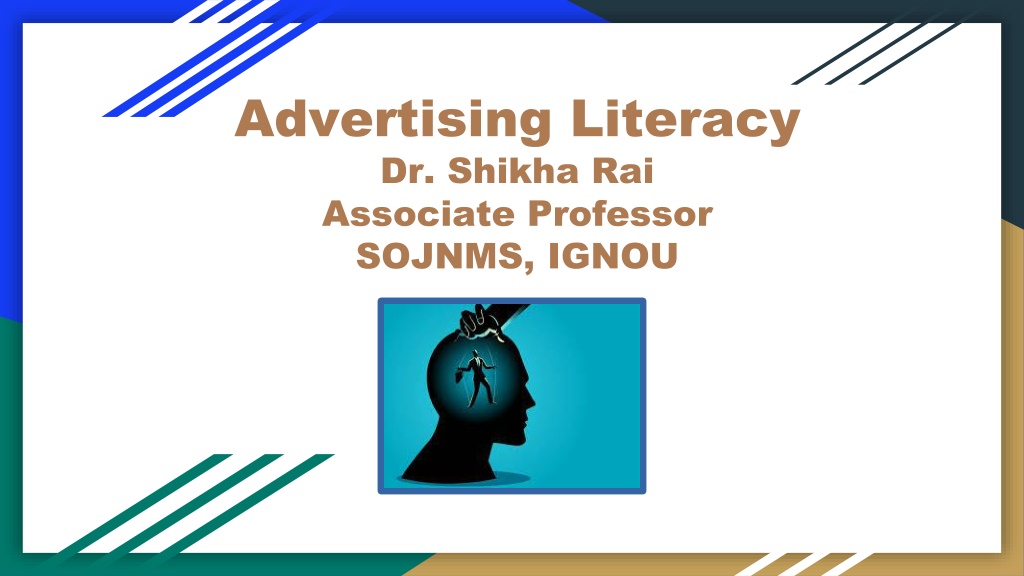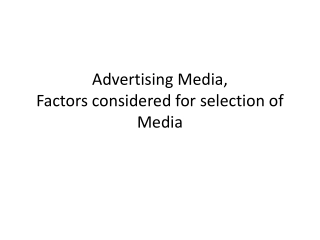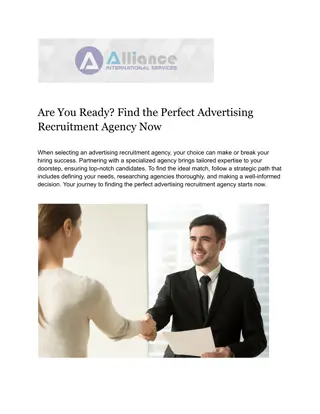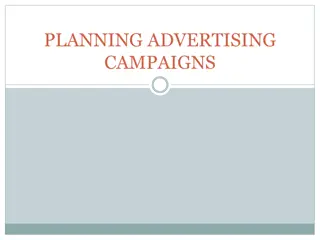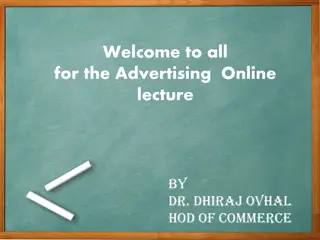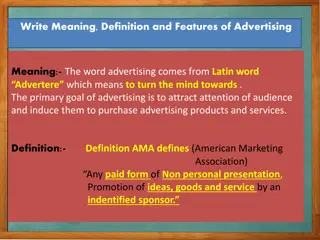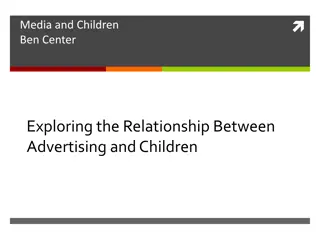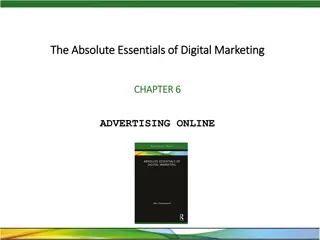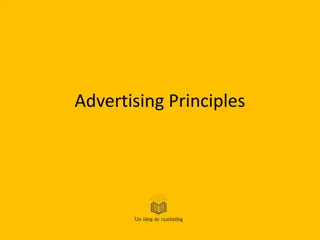Understanding Advertising Literacy: Impact and Influence in Today's World
Advertising surrounds us, influencing our choices and behaviors more than we realize. From newspapers to digital media, the reach of ads is extensive. This form of persuasion shapes perceptions, fosters materialism, and manipulates desires. Advertisers strategically inform, persuade, remind, and reinforce brand messages to create a lasting impact. Understanding the objectives and effects of advertising is crucial in navigating today's commercial landscape.
Download Presentation

Please find below an Image/Link to download the presentation.
The content on the website is provided AS IS for your information and personal use only. It may not be sold, licensed, or shared on other websites without obtaining consent from the author. Download presentation by click this link. If you encounter any issues during the download, it is possible that the publisher has removed the file from their server.
E N D
Presentation Transcript
Advertising Literacy Dr. Shikha Rai Associate Professor SOJNMS, IGNOU
Advertising is everywhere! Newspapers Television Digital Media Games Websites Mobile Billboards Retail Stores Metros Sports Events Movie Theatres
Advertising is everywhere! Estimates range from 247 to over 5,000 for the number of ads the average person is exposed per day (American Advertising in the Media). Even if we take the figure at the low end of this range, that is more than 15 ad exposures for every waking hour of every day. Sixty percent of the typical newspaper is advertising. Forty percent of television content is advertising. The typical Internet user is served 1,707 banner ads per month. Ads are on the sides of buildings, on taxis and buses, on police cruisers, in public toilets, on gas pumps, on the back of store receipts, on church bulletins, in public school classrooms, and even on the clothing of people walking the streets.
Advertising A Paid form of presentation and promotion of ideas and products by an identified sponsor through a medium. The most important product of advertising is you. Advertisers have conditioned us to give them our time and money by appealing to what we think we need. Most of us do not realize how much advertising exposure we experience every day and how it has shaped our attitudes and behaviors.
Advertising Objectives Four Main Objectives: 1. Inform: Inform people about what the product is and what it does. 1. Persuade: Inducing people to buy the products and give reasons to lure the customers. 1. Remind: Keep reinforcing the central message. 1. Reinforce: Convince current customers that they have made the right choice.
Effects of Advertising Promotes commercialism and materialism: The ideas that turns everything into objects sold for the purpose of generating profit, and that happiness and success are tied to buying more things. This leads to a focus on material wealth and overconsumption. Creates false desire: Advertisers play with emotions, aspirations and social status of people, and makes them believe that they really need and desire a particular product. Brand Loyalty: Advertisers create a strong brand identity that consumers can relate to, which encourages repeat purchases. This often involves creating a narrative around the brand that aligns with the consumer's values and lifestyle. Manipulation of vulnerable populations (children, the elderly), perpetuation of stereotypes, and the promotion of unhealthy or unsustainable consumption patterns have also been observed.
Advertising Appeals Informational or argument-based appeal : They straightforwardly informed consumers what was for sale, at what price and where one could buy it. The approach became known as the tell approach, a more subtle variant of the more pressing hard-sell approach of salemanship in print which aligned a set of persuasive arguments to convince prospective buyers and thus became known as the reason-why approach . E.g. Durable products like computers or washing machines Emotional or affect-based appeal: aiming to influence the consumer s feelings and emotions rather than his thoughts. The development of the soft-sell approach was in line with the societal and academic trend of the time increasingly to view human nature as governed by instinct, emotions and non-rational processes E.g. Wine, soft drink, perfumes.
Emotional Appeals Happiness: a brand creates a commercial that features people smiling and enjoying themselves, so the viewers associate the company with happiness. Sadness: An earthquake devastates a town, and a local nonprofit organization airs a commercial to raise money for a relief program. The viewer is sad about the devastation and consequently donates to the fund. Fear: a recycling advertisement includes visuals that show what the earth will look like if excessive pollution persists, which can persuade viewers into recycling more frequently.
Emotional Appeals Adventure: a store that sells camping equipment launches an advertisement with people hiking to a mountain peak with spectacular views. The consumer buys the tents, hoping to have a similar outdoor experience. Popularity: For example, an advertisement for a leather purse displays a compilation of customers wearing the purse, showing how popular it is and piquing curiosity among viewers. Gratification: a sunscreen brand provides instant moisture and protection for UV rays, so consumers can feel gratified by using it.
Humor Example: Those 5 star ads are so funny, I think I ll go eat one.
Celebrity Testimonials Example: If Kareena Kapoor uses Head & Shoulders and says it s the best, then that s what I ll buy.
Playing on emotions Example: This ad reminds me of the time when I used to sip tea and talk to my friends.
Fear Appeal Example: These products are so healthy, I need them if I want to live a healthy life.
Hidden Advertising An advertising technique where references to specific brands or products are incorporated into another work, such as a film or television program, with specific promotional intent. Eg: Domino s Pizza arriving in 30 minutes in Phir Hera Pheri.
Blurring lines: Influencer Marketing Individuals with substantial followings often collaborate with brands, seamlessly integrating products into their content. Unlike traditional ads, these promotions often masquerade as organic posts, making it challenging for users to differentiate between genuine recommendations and paid endorsements. Sometimes, these posts seem very genuine and make audiences feel that the influencer is speaking from the heart and telling his real life experience, rather than promoting a product.
Media Literacy Media literacy refers to the ability to read and critically analyse different forms and means of media representation. The development of personal media literacy begins with the realization that every day, we receive thousands of messages that can potentially influence our opinions, attitudes, values and behaviour.
Advertising Literacy - Abilityto understand, interpret and critically evaluate advertising messages. - Skills needed to discern the persuasive intent behind advertisements and to recognize the techniques used to influence consumers . - Empowers individuals to make informed decisions and resist manipulative advertising tactics. - Crucial for fostering critical thinking and protecting consumers from deceptive practices
Dimensions of Advertising Literacy Informational literacy: Ability to use various sources of Information and to evaluate the correctness of information. Visual /Aesthetic literacy: Understanding of the forms of auditory and visual expressions as well as styles, stories and references. Rhetorical literacy: Understanding of the means and tactics of persuasion. Promotional literacy: Understanding of the logic of product placement, branded media contents, sponsorships and publicity.
Components of Advertising Literacy Advertising Recognition: People s ability to identify a message as advertising. Advertising Understanding: People s ability to understand advertising s commercial intent. Selling intent: advertising aims to sell product for profitable reasons. Persuasive intent: advertising aims to change someone s opinions about a product. Source: Understanding who pays for advertising messages.
Components of Advertising Literacy Intended audience: understanding the concept of audience targeting and segmentation Persuasive tactics: understanding specific strategies used by advertisers to enhance and idealize the product Bias: being aware of discrepancies between the advertised and the actual product.
Types of skills needed Cognitive Skills - Ability to analyze an advertisement to identify key elements of persuasion - Ability to compare and contrast key elements of persuasion in the ad with facts in your Real-world knowledge structure - Ability to evaluate veracity of claims in the ad
Types of skills needed Emotional Skills - Ability to analyze the feelings of people in the ad (would they really feel what ad is showing them to be feeling) Ability to put oneself into the position of different people in the ad (would they really act in this way) - Aesthetic Skills - - Ability to analyze the craft and artistic elements of the ad Ability to compare and contrast the artistry used to craft this ad with that used to craft
Types of skills needed Moral Skills - - Ability to analyze the moral elements of an ad Ability to evaluate the ethical responsibilities of advertisers Ability to analyse personal needs - The more you are aware of your needs, the more you can use advertising to control your life. If you are not aware of your needs, the constant flood of advertising messages will create and shape your needs often without you knowing it. -
How to Analyse Advertisements 1. What is the main product claim (reason for buying the product) of the ad? 2. Is the claim presented explicitly or implicitly (you have to infer it)? 3. What is the intention of the ad (awareness, positive emotion, change attitude, inoculation, reinforcement, buy product)? 4. Is the ad more emotional or rational? 5. If emotional, which emotion was evoked? Why this emotion? 6. If rational, how much information was presented? Were the right facts presented? 7. Did the ad use a product spokesperson? If so, why was this person chosen? 8. What was the message strategy of the ad? 9. What is the tone of the ad? 10.Look beyond the surface of the ad and the particular product. Can you see some underlying values that the ad is teaching?
Evaluating Advertising Messages Audiences regularly need to ask themselves these questions: Which ads evoked the strongest emotions in me? What were those emotions? how the ad triggered those particular emotions. Which ads were the best from an aesthetic point of view? Is there something about the writing, directing, editing, lighting, set design, costuming, or music/sound effects that I found of particularly high quality? Which ads were most upsetting from a moral perspective? What ethical considerations were raised? Overall, which of the ads were most persuasive to me? Why? Did these ads present the best reasons for why the product would satisfy your needs? Which ads were most exploitive, that is, tried to convince you of false needs?
